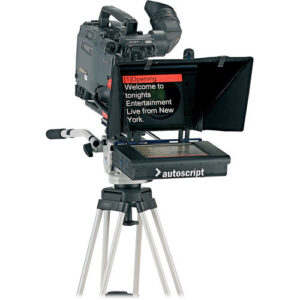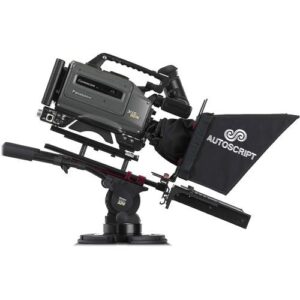Does every shoot benefit from a device that displays the script right in front of the presenter, so they can have all their lines right there?
You’d think the answer would be simple but depending on who’s in front of the camera, teleprompters can speed up or slow down production. So when is a teleprompter the best way to go? And when isn’t it? Let’s start with a crash course on what makes it tick.
How does it work?
A teleprompter is a reflective screen that’s mounted in front of the camera lens. That screen is a one way mirror that the camera can film through, placed in front of the camera at a 45-degree angle. At the same time, there’s a screen with the script (backward and upside down) placed below it. Special teleprompter software reverses the words on the screen, so the presenter sees them normally.


Generally, a teleprompter comes with an operator who adjusts the format and scrolling speed of the text on the screen to pace it at a comfortable, natural flow for the presenter.
That sounds amazing! Let’s get one!
Sure, a teleprompter can be a huge help on a shoot, boosting the presenter’s confidence and reducing the number of takes needed. But in other cases, it can actually make the presenter more awkward on camera. How can that be?
The Advantages of a Teleprompter
- It builds trust with viewers: The speaker looks directly into the camera. It’s like the presenter is speaking directly to each person watching, and that eye contact can help build a sense of trust with the viewer.
- No more rote memorization: The speaker doesn’t have to memorize a long text, lists, or hard-to-pronounce names. That’s less stressful for the video’s stars so they can be more relaxed on camera
- Fewer flubs: The shoot can go more smoothly and quickly as there should be fewer forgotten lines and retakes.
The Disadvantages
- Cost – You’ll need to have an extra person on set to run the teleprompter
- Compulsion to read: Some people just can’t stop themselves from reading every word. ’ That’s usually a symptom that the person doesn’t know their script well or isn’t comfortable with it. So it’s especially essential that the presenter practice their part before the shoot.
- Lack of experience with the tool: Even knowing the script’s content, many people will still sound stilted. That’s because it actually takes experience and practice to sounds casual and unpracticed. Part of the awkwardness comes from only seeing a few lines of script onscreen at a time. More experienced teleprompter users learn to read ahead and keep the next line in mind so it comes off with a natural flow. News anchors make it look easy but that ease comes from years of experience with a teleprompter!
- Left, right, left, right: It can also be very obvious that someone is reading, with the tell-tale sign of the eyes scanning left and right. A larger teleprompter screen placed farther back can dramatically lessen this effect, though.
So to recap- a teleprompter is a fantastic tool if you’re working with on-camera talent who has experience using it. But for most newcomers to the tool, it’s likely to need a steep learning curve and may add significant time and frustration to your shoot!
Would you like to discuss if a teleprompter would be best for your next production? Contact us and we’ll talk!
